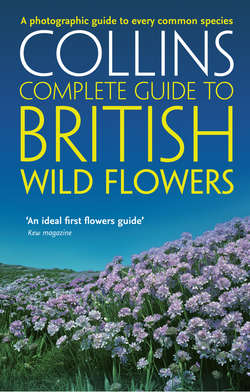Читать книгу British Wild Flowers: A photographic guide to every common species - Paul Sterry - Страница 11
FRUITS AND SEEDS
ОглавлениеFRUITS FOLLOW IN THE wake of flowers and are the structures in which a plant’s seeds develop and are protected. In many cases, the shape and structure of these fruits, and often the seeds themselves, are designed to assist their dispersal, when ripe, away from the plant that produced them. A number of ingenious methods have evolved to facilitate this process: some seeds are carried by the wind; others attach themselves to the fur of animals; some even float away on water or have evolved to be eaten and digested by birds. The study of fruits and seeds is not only fascinating in its own right but in many instances the structure or appearance of a fruit can be a valuable aid to correct identification.
The burred fruits of Lesser Burdock readily become snagged in animal fur, travelling with the creature until the fruit finally disintegrates and liberates the seeds.
The hook-tipped spines on the fruit of Wood Avens catch in animal fur. Subsequently, they also help the fruit to disintegrate, as unattached barbs snag on objects and material that the animal rubs against.
The flowers of Common and Grey Field-speedwells are rather similar. Only by looking at the fruits (Common left, Grey right) can you be absolutely certain of any given plant’s identity.
Cabbage family members produce fruits known as pods, which vary considerably in terms of size and shape according to species. Those of Wild Candytuft, seen here, are particularly attractive.
Dandelion seeds are armed with a tuft of hairs – the pappus – that assists wind dispersal. While it remains intact, the collection of seeds and hairs is often referred to as a ‘clock’.
The fruits of Field Gromwell are hard-cased nutlets, designed to be resistant to abrasion and wear, allowing the species to grow as an arable weed, but of course only in the absence of herbicides.
Like other members of the pea family, the fruits of bird’s-foottrefoil are elongated pods.
The seeds of Elder are contained within luscious berries. These are eaten by birds and the seeds (protected by a coating resistant to being digested) are dispersed with the droppings.
The fruits of roses are fleshy and known as hips; inside these are seeds (dry achenes).
The fruit of the Common Poppy is a hollow vessel that contains thousands of minute seeds. When the fruit is ripe, holes below its rim allow seeds to escape when the plant is shaken by the wind.
In strict botanical terms, the fruits of the Raspberry are a collection of small drupes – each one a fleshy fruit that contains a hard-coated seed.
